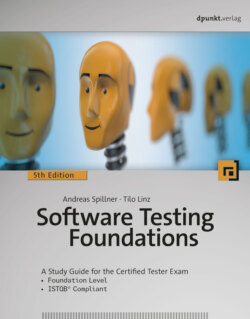Software Testing Foundations

Реклама. ООО «ЛитРес», ИНН: 7719571260.
Оглавление
Andreas Spillner. Software Testing Foundations
About the Authors
Software Testing Foundations
Preface to the 5th Edition
Foreword by Yaron Tsubery
Overview
Contents
1 Introduction
2 Software Testing Basics
2.1 Concepts and Motivations
2.1.1 Defect and Fault Terminology
2.1.2 Testing Terminology
2.1.3 Test Artifacts and the Relationships Between Them
2.1.4 Testing Effort
2.1.5 Applying Testing Skills Early Ensures Success
2.1.6 The Basic Principles of Testing
2.2 Software Quality
2.2.1 Software Quality according to ISO 25010
2.2.2 Quality Management and Quality Assurance
2.3 The Testing Process
2.3.1 Test Planning
2.3.2 Test Monitoring and Control
2.3.3 Test Analysis
2.3.4 Test Design
2.3.5 Test Implementation
2.3.6 Test Execution
2.3.7 Test Completion
2.3.8 Traceability
2.3.9 The Influence of Context on the Test Process
2.4 The Effects of Human Psychology on Testing
2.4.1 How Testers and Developers Think
2.5 Summary
3 Testing Throughout the Software Development Lifecycle
3.1 Sequential Development Models
3.1.1 The Waterfall Model
3.1.2 The V-Model
3.2 Iterative and Incremental Development Models
3.3 Software Development in Project and Product Contexts
3.4 Testing Levels
3.4.1 Component Testing
3.4.2 Integration Testing
3.4.3 System Testing
3.4.4 Acceptance Testing
3.5 Test Types
3.5.1 Functional Tests
3.5.2 Non-Functional Tests
3.5.3 Requirements-Based and Structure-Based Testing
3.6 Testing New Product Versions
3.6.1 Testing Following Software Maintenance
3.6.2 Testing Following Release Development
3.6.3 Regression Testing
3.7 Summary
4 Static Testing
4.1 What Can We Analyze and Test?
4.2 Static Test Techniques
4.3 The Review Process
4.3.1 Review Process Activities
Planning
Initiating a Review
Individual Review Preparation
Issue Communication and Analysis
Fixing and Reporting
4.3.2 Different Individual Review Techniques
Ad hoc
Checklist-Based
Using Scenarios and Dry Runs7
Role- and Viewpoint-Based
4.3.3 Roles and Responsibilities within the Review Process
Management10
Review leader
Facilitator/Moderator
Author
Reviewer
Scribe
4.4 Types of Review
Informal Review
Walkthrough
Technical Review
Inspection
4.5 Critical Factors, Benefits, and Limits
Organizational Success Factors
People-Related Success Factors
4.6 The Differences Between Static and Dynamic Testing
4.7 Summary
5 Dynamic Testing
5.1 Black-Box Test Techniques
5.1.1 Equivalence Partitioning
Test Cases
Defining Exit Criteria
Benefits and Limitations
5.1.2 Boundary Value Analysis
Test Cases
Defining Exit Criteria
Benefits and Limitations
5.1.3 State Transition Testing
Test Cases
Defining Exit Criteria
Benefits and Limitations
5.1.4 Decision Table Testing
Test Cases
Defining Exit Criteria
Benefits and Limitations
5.1.5 Pair-Wise Testing24
Orthogonal and Covering Arrays
n-wise Testing
Test Cases
Defining Exit Criteria
Benefits and Limitations
Testing Tools
5.1.6 Use-Case Testing
Test Cases
Defining Exit Criteria
Benefits and Limitations
5.1.7 Evaluation of Black-Box Testing
5.2 White-Box Test Techniques
5.2.1 Statement Testing and Coverage
Test Cases
Defining Exit Criteria
Benefits and Limitations
5.2.2 Decision Testing and Coverage
Test Cases
Defining Exit Criteria
Benefits and Limitations
5.2.3 Testing Conditions
Branch Condition Testing29
Branch Condition Combination Testing
Modified Condition Decision Coverage Testing (MCDC)
Test Cases
Defining Exit Criteria
Benefits and Limitations
Path Testing31
Other White-Box Testing Techniques
5.2.4 Evaluation of White-Box Testing
5.3 Experience-Based Test Techniques
Intuitive Test Case Derivation
Checklist-Based Testing
Exploratory Testing
Test Cases
Defining Exit Criteria
Benefits and Limitations
5.4 Selecting the Right Technique
5.5 Summary
6 Test Management
6.1 Test Organization. 6.1.1 Independent Testing
6.1.2 Roles, Tasks, and Qualifications
6.2 Testing Strategies. 6.2.1 Test Planning
6.2.2 Selecting a Testing Strategy
6.2.3 Concrete Strategies
6.2.4 Testing and Risk
6.2.5 Testing Effort and Costs
6.2.6 Estimating Testing Effort
6.2.7 The Cost of Testing vs. The Cost of Defects
6.3 Test Planning, Control, and Monitoring
6.3.1 Test Execution Planning
6.3.2 Test Control
6.3.3 Test Cycle Monitoring
6.3.4 Test Reports
6.4 Defect Management
6.4.1 Evaluating Test Reports
6.4.2 Creating a Defect Report
6.4.3 Classifying Failures and Defects
6.4.4 Defect Status Tracking
6.4.5 Evaluation and Reporting
6.5 Configuration Management
6.6 Relevant Standards and Norms
6.7 Summary
7 Test Tools
7.1 Types of Test Tools
7.1.1 Test Management Tools
7.1.2 Test Specification Tools
7.1.3 Static Test Tools
7.1.4 Tools for Automating Dynamic Tests
How Capture/Replay Tools Work
7.1.5 Load and Performance Testing Tools
7.1.6 Tool-Based Support for Other Kinds of Tests
7.2 Benefits and Risks of Test Automation
7.3 Using Test Tools Effectively. 7.3.1 Basic Considerations and Principles
7.3.2 Tool Selection
7.3.3 Pilot Project
7.3.4 Success Factors During Rollout and Use
7.4 Summary
AImportant Notes on the Syllabus and the Certified Tester Exam
BGlossary
CReferences. C.1 Literature
C.2 Norms and Standards
C.3 URLs1
Index. A
B
C
D
E
F
G
H
I
J
K
L
M
N
O
P
Q
R
S
T
U
V
W
2 Software Testing Basics
3 Testing Throughout the Software Development Lifecycle
4 Static Testing
5 Dynamic Testing
6 Test Management
7 Test Tools
C References
Отрывок из книги
Andreas Spillner is emeritus professor of computer science at the University of Applied Sciences Bremen. During the 1990s and early 2000s he spent 10 years as spokesman for the TAV (Test, Analysis, and Verification) group at the Gesellschaft für Informatik (German Computer Science Society) that he also helped to found. He is a founder member of the German Testing Board and was made an honorary member in 2009. He was made a fellow of the Gesellschaft für Informatik in 2007. His software specialty areas are technology, quality assurance, and testing.
Tilo Linz is co-founder and a board member of imbus AG, a leading software testing solution provider. He has been deeply involved in software testing and quality assurance for more than 25 years. As a founding member and chairman of the German Testing Board and a founding member of the International Software Testing Qualifications Board, he has played a major role in shaping and advancing education and training in this specialist area both nationally and internationally. Tilo is the author of Testing in Scrum (published by Rocky Nook), which covers testing in agile projects based on the foundations presented in this book.
.....
A test process8 will generally comprise the following activities (see figure 2-3):
Each of these activities comprises multiple individual tasks that produce their own output and vary in nature according to the project at hand.
.....